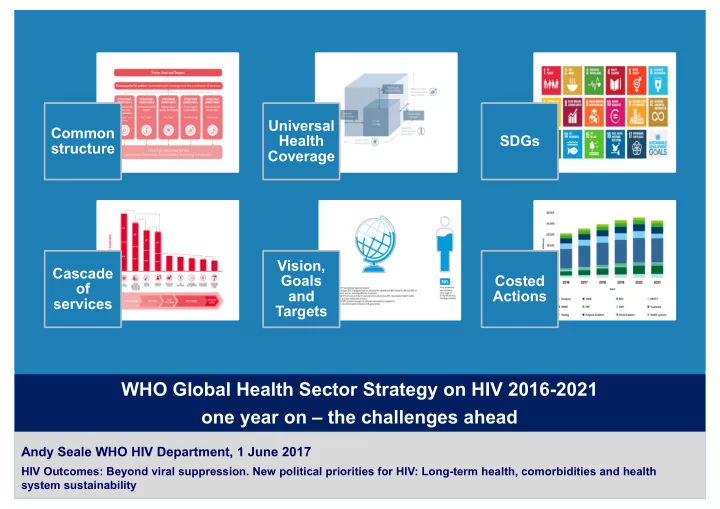

Universal Common Health SDGs structure Coverage Vision, Cascade Goals Costed of and Actions services Targets WHO Global Health Sector Strategy on HIV 2016-2021 one year on – the challenges ahead Andy Seale WHO HIV Department, 1 June 2017 HIV Outcomes: Beyond viral suppression. New political priorities for HIV: Long-term health, comorbidities and health system sustainability
Presentation overview § Setting the scene § The global health sector strategy and regional action plan on HIV 2016- 2021 – adopted in 2016 § Strategy innovations related to chronic care § Monitoring progress: TB/HIV and other comorbidities § Future challenges 2 |
HIV, chronic care and ageing Professor Peter Reiss summarized existing evidence at the December 2016 PCB Thematic session and concluded by summarizing lessons learned so far: § Comorbidity burden consistently increased in HIV as people age – co-infections and NCDs – TB is still leading cause of death in eastern part of region § Traditional lifestyle-related -factors are key drivers § There is additional risk from ART for some but not all co-morbidities § Longer time spent at low CD4 counts, rather than longer overall exposure to ART, generally contributes to greater risk § Persistent inflammation and innate immune activation contributes towards risk for some but not all co-morbidities § Promotion of healthy lifestyle and management of traditional risk are key § Early HIV diagnosis and treatment initiation reduces risk Prof Reiss presentation to PCB Dec 2016 http://www.unaids.org/sites/default/files/media_asset/20161208_UNAIDS_PCB39_T 3 | hematic_Dr_Reiss_PPT.pdf
HIV co-infection among TB patients continues to rise in Europe, 2015 Between 2011 and 2015 percentage of HIV/TB co-infection almost doubled , from 5.5% to 9.0% Source : European Centre for Disease Prevention and Control/WHO Regional Office for Europe. Tuberculosis surveillance and monitoring in Europe 2017. 4 |
An accelerated HIV response at global, regional and country levels Global HIV and European Hepatitis Action Strategies, Plans, 2016-21 HIV and HEP National HIV Strategies and Plans World Health Assembly (WHA69) – Global strategies adopted (May 2016) Regional Committee (RC66) – Regional Action Plans adopted (Sep 2016) Global strategy Regional Action Plans National Strategies
6 |
7 |
2020 strategic targets § Reduce tuberculosis deaths among people living with HIV by 75% § Reduce hepatitis B and C deaths among people co-infected with HIV by 10%, in line with mortality targets for all people with chronic hepatitis B and C infection § Provision of access by 90% of countries to integrated health services covering HIV, tuberculosis, hepatitis B and C, reproductive health and sexually transmitted infections* * Not in the regional action plan 8 |
Examples of programmatic indicators Progress monitoring supported by a number of programmatic indicators included in the Consolidated Strategic Information Guidelines for HIV in the health sector - for example: § % of PLHIV in HIV care who were screened for TB in HIV care settings § % of PLHIV and newly enrolled in HIV care who have active TB disease § % of PLHIV and newly enrolled in HIV care who have started on TB preventive therapy § % of PLHIV who complete the course of TB preventive therapy § % of PLHIV in HIV care who were screened for hepatitis B § % of PLHIV in HIV care who were screened for hepatitis C Consolidated strategic information guidelines for HIV in the health sector 9 | http://www.who.int/hiv/pub/guidelines/strategic-information-guidelines/en/
Accountability Framework for Strategy Implementation Strategy Area Accountability A. Goals and Targets 1. SDG reporting process : HIV responsible progress on HIV incidence, mortality and HIV treatment as part of universal access (2020 targets) -Incidence, Mortality 2. Global AIDS Monitoring (GAM) : progress to 90, 90, 90 by 2020 (WHO responsible for -90, 90, 90 validation of 90, 90, 90 targets) 3. Global AIDS Monitoring (GAM) : additional indicators with UNAIDS, hepatitis and TB -Discrimination (TB, Hep B and C deaths among co-infected, discrimination PLHIV and health sector, -TB, Hep B and C financing and integration see below) 4. Global Reports : Baseline, mid-term (2018) and end of strategy (2020) with • Formal, process evaluation and review to input and form next strategy B. Strategic Directions 1-5 1. The “What”, “How” and “Where” – progress to 90, 90, 90 Implementation of key guidelines and policy adaptation – country intelligence • annual and biannual accountability -Implement strategy Closing Cascade gaps in fast track countries - annual review of national and sub • directions national cascade gaps with cascade data and analysis 2. “Financing”, “Integration ”, “Innovation” – finance and domestic investments reach 26 -Financing, integration and US$ billion, 90% countries integrated HIV, TB, Hep, STI services innovation Review of country strategies for integration, financing, inclusion innovations, and • of key populations (2018). Country Intelligence to track one key innovation per area of guidelines e.g. self testing, new drugs, unique identifiers C. WHO Actions – 1. Country Intelligence – annual review of WHO actions by strategy action by country. Epi 10 country actions and impact and Impact reviews with each region for 2018 report on implementation
Future challenges § The dynamic nature of the epidemic and response § Constrained resources and competing health and development priorities § Working towards greater intersections between health and social care – including on how health systems finance this in the context of ageing populations § HIV drug resistance § Monitoring and evaluating progress at each stage of the expanded continuum of services WHO plans to disseminate new guidelines for patient monitoring and case-based surveillance this year to support country efforts to improve treatment adherence and viral suppression among people on ART and to strengthen chronic care 11 |
Thank you References Prof Peter Reiss presentation to PCB Thematic http://www.unaids.org/sites/default/files/media_asset/20161208_UNAIDS_PCB39_Thematic_Dr_Reiss_PPT.pdf WHO global health sector strategy on HIV 2016-2021 http://www.who.int/hiv/strategy2016-2021/ghss-hiv/en/ WHO Prevent HIV, test and treat all - WHO support for country impact. Progress Report 2016. http://www.who.int/hiv/pub/progressreports/2016-progress-report/en/ WHO Action plan for the health sector response to HIV in the WHO European Region http://www.euro.who.int/__data/assets/pdf_file/0006/318318/European-action-plan-HS-HIV.pdf?ua=1 WHO Guidelines http://www.who.int/hiv/en/ 12 |
Recommend
More recommend